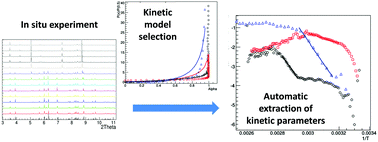当前位置:
X-MOL 学术
›
Phys. Chem. Chem. Phys.
›
论文详情
Our official English website, www.x-mol.net, welcomes your
feedback! (Note: you will need to create a separate account there.)
Principal component analysis for automatic extraction of solid-state kinetics from combined in situ experiments
Physical Chemistry Chemical Physics ( IF 2.9 ) Pub Date : 2018-07-05 00:00:00 , DOI: 10.1039/c8cp02481b Pietro Guccione 1, 2, 3, 4, 5 , Luca Palin 4, 6, 7, 8, 9 , Benny Danilo Belviso 3, 4, 5, 10 , Marco Milanesio 4, 8, 9, 11 , Rocco Caliandro 3, 4, 5, 10
Physical Chemistry Chemical Physics ( IF 2.9 ) Pub Date : 2018-07-05 00:00:00 , DOI: 10.1039/c8cp02481b Pietro Guccione 1, 2, 3, 4, 5 , Luca Palin 4, 6, 7, 8, 9 , Benny Danilo Belviso 3, 4, 5, 10 , Marco Milanesio 4, 8, 9, 11 , Rocco Caliandro 3, 4, 5, 10
Affiliation

|
Solid-state reactivity is often studied by in situ experiments with a multi-technique approach, where complementarity of different probes is exploited. In situ data are usually analysed using a complex protocol: first the reaction model most suited to describe the specific solid-state reaction is chosen, second the reaction coordinate is obtained from the data, the order of reaction is then calculated by applying a specific kinetic equation, and finally kinetic parameters are obtained with an Arrhenius plot. The approach is both time consuming and subject to errors due to the arbitrariness of extraction of the reaction coordinate, typically from individual peak intensity variations during the reaction. In addition, application of the different kinetic equations to obtain the best fitting one is tedious and no general method to select the best model with an unbiased approach is available. Here we propose a new procedure based on principal component analysis to get kinetic information from in situ data, which simplifies and speeds up the process of kinetic parameter calculation from a three- to a two- or even a one-step form, reaching a high degree of automation and the ability to manage the huge amount of data produced by in situ multi-technique experiments. The new approach treats data as a whole, without biases introduced by manual methods of obtaining the reaction coordinate by peak intensity evaluation from individual patterns typical of the traditional approach. The procedure is described in its theoretical framework and applied to the formation of a molecular complex, monitored by in situ X-ray powder diffraction and Raman measurements.
中文翻译:

从组合原位实验中 自动提取固态动力学的主成分分析
固态反应性通常是通过采用多种技术的原位实验研究的,其中利用了不同探针的互补性。原位通常使用复杂的协议分析数据:首先选择最适合描述特定固态反应的反应模型,其次从数据中获得反应坐标,然后通过应用特定的动力学方程式计算反应顺序,最后通过阿伦尼乌斯图获得动力学参数。该方法既耗时又由于通常任意地从反应期间的各个峰强度变化中提取反应坐标而导致错误。另外,应用不同的动力学方程式来获得最佳拟合是一件很乏味的事情,并且没有可用无偏方法选择最佳模型的通用方法。在这里,我们提出了一种基于主成分分析的新程序,可以从中获取动力学信息。原位数据,这简化并加速了动力学参数计算的从处理的三到二维或甚至单步形式,达到自动化程度高的,并管理数据的所产生的巨大的量的能力在原位多技术实验。新方法将数据作为一个整体进行处理,而没有手动方法引入的偏差,该方法是通过从传统方法的典型模式中通过峰强度评估获得反应坐标的手动方法而引入的。该程序在其理论框架中进行了描述,并应用于分子复合物的形成,并通过原位X射线粉末衍射和拉曼测量进行监测。
更新日期:2018-07-05
中文翻译:

从组合原位实验中 自动提取固态动力学的主成分分析
固态反应性通常是通过采用多种技术的原位实验研究的,其中利用了不同探针的互补性。原位通常使用复杂的协议分析数据:首先选择最适合描述特定固态反应的反应模型,其次从数据中获得反应坐标,然后通过应用特定的动力学方程式计算反应顺序,最后通过阿伦尼乌斯图获得动力学参数。该方法既耗时又由于通常任意地从反应期间的各个峰强度变化中提取反应坐标而导致错误。另外,应用不同的动力学方程式来获得最佳拟合是一件很乏味的事情,并且没有可用无偏方法选择最佳模型的通用方法。在这里,我们提出了一种基于主成分分析的新程序,可以从中获取动力学信息。原位数据,这简化并加速了动力学参数计算的从处理的三到二维或甚至单步形式,达到自动化程度高的,并管理数据的所产生的巨大的量的能力在原位多技术实验。新方法将数据作为一个整体进行处理,而没有手动方法引入的偏差,该方法是通过从传统方法的典型模式中通过峰强度评估获得反应坐标的手动方法而引入的。该程序在其理论框架中进行了描述,并应用于分子复合物的形成,并通过原位X射线粉末衍射和拉曼测量进行监测。











































 京公网安备 11010802027423号
京公网安备 11010802027423号